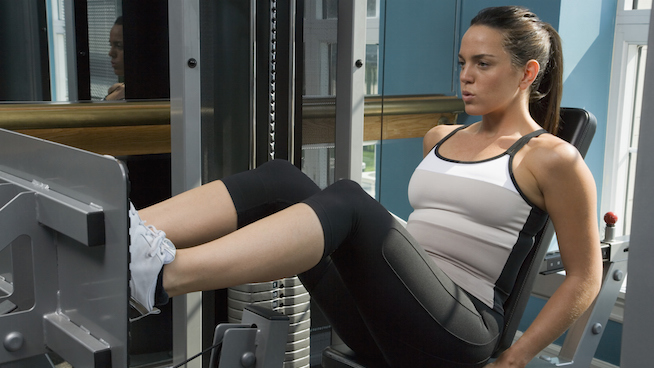In this post I’ll explain how to set up the leg press machine to get the best results and what to check if you’re experiencing issues.

The leg press challenges many of the muscles in the lower body including the quadriceps, hamstrings, glutes and calves.
It offers a safer alternative to the free weight loaded squat with comparable results.
Let’s take a look how best to set up the exercise to maximise your results and reduce your risk of injury.
How to set up the leg press
Because the leg press challenges more than one joint, to perform the exercise safely and effectively you’ll need to assess range of motion at both your hip and ankle.
In some cases, particularly if there’s very limited motion, you’ll also need to check range of motion at your knee.
How to assess hip flexion range of motion
Sit on the machine with your feet on the platform at a comfortable width. Place your hands between your lower back and the seat and slowly lift one leg away from the platform.
You should have enough space to move each leg away from the platform a little without moving your pelvis. If you feel the pressure on your hands increase, this means your pelvis has moved.
Adjust how far the platform comes towards you, or how far you come toward the platform to make sure this doesn’t happen.
On some machines you can also adjust the angle of the seat back. Use this to find a comfortable trunk position. Be aware the more vertical the seat, the further away the platform will need to be to accommodate for this.
How to check ankle range of motion
Now move your feet vertically up the platform until you’re able to lift the front of your feet slightly off its surface. This will ensure the machine doesn’t take your ankle into a passive range of motion at the bottom position of the press.
Checking knee flexion
If you have particularly limited range of motion at your knee, now is a good time to make sure the machine won’t breach this when the platform is closest to you.
Check this by slowly letting the platform comes towards you with no weight on the stack. Attempt to bend each knee further in the bottom position of the exercise. If you’re unable to do this set the platform further away from you.
If this leaves a very small operating range for the exercise, it might be best to work on your knee flexion and extension on single joint exercises like the leg extension and leg curl first.
Finding the right width for your hips
This will be slightly different for everybody because of individual differences in hip joint structure. It should be relatively intuitive however. Experiment with a light weight and see what feels comfortable.
Once you’ve chosen your ideal width, make sure your knees are pointing in the same direction as your feet. The further apart your feet are, the more you will have to turn your feet outwards as a result.
Your knees should stay pointing in the same direction as your feet throughout the exercise. Make sure they don’t fall either inwards or outwards of your feet.
If they do recheck your start position as this may be due to the machine taking you into a passive range of motion at either your ankle or hip.
If the start position is good, try applying a slight pressure on either the outside of your feet, to prevent inward knee movement, or the inside to prevent outward knee movement.
Performing the leg press
To start the exercise brace yourself in the seat by taking hold of the handles and slowly push the platform away from you.
Approach the end of the range with caution. Particularly if your knees have a tendency to go beyond straight. Leave a small bend in the knee to be safe.
As the platform comes back towards you, ensure your torso doesn’t move in the seat before slowly pressing away again.
Recap
- Check your active range of motion at your hip, ankle and knee before you begin and adjust the seat and your foot placement to accommodate for all three.
- Brace yourself firmly back in the seat before you press and make sure you stay there throughout the exercise.
- Slow down as you approach either end of the exercise as if you were parking a car in small space. The end joint ranges need to be treated with care so don’t slam into them.